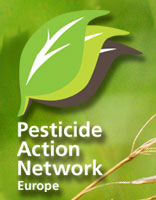NEW! PAN Europe research review
’Pesticides and the loss of biodiversity: How intensive pesticide use affects wildlife populations and species diversity’
In the UN International Year of Biodiversity, this PAN Europe review summarises recent research findings from the scientific literature on the impact of pesticides on biodiversity, with specific chapters on:
- Birds
- Bees & butterflies
- Mammals
- Plants
- Amphibians and aquatic species
- Soil
The review covers mainly European and North American studies but includes key findings from other continents. The findings are highly relevant among others to promote the meaningful implementation of the Directive 2009/128/EC finalised in October 2009 on Sustainable Use of Pesticides. We hope you will use it as basis in the stakeholder debate on National Action Plans currently under development in Member States.
Some of the findings:
- In farmland habitats, population declines have occurred in about half of plants, a third of insects and four-fifths of bird species (Robinson and Sutherland, 2002). There are numerous factors responsible for biodiversity declines, including loss of habitat, changes in agricultural practices, changing weather patterns, the arrival of exotic invasive pests, as well as agrochemical use. This review focuses on pesticide-related effects, both directly on specific organisms and indirectly on their food sources, shelter and ecological habitat.
- Pesticide dependency and intensity has increased in the last decades, for example, between 1990 and 2006, the total area treated with pesticides increased by 30% in the UK, and the herbicide-treated area increased by 38% (Fera, 2009).
- This research review explains how herbicides can cause changes in vegetation and habitat which threaten mammals, while insecticides may reduce the availability of important food insects. Pesticides and other chemicals have caused population declines in wild mammals, for example, mostly bats and rodents (Harris 1995), while herbicide use can affect mammals such as the common shrew, wood mouse and badger by removing plant food sources and changing the microclimate (Hole et al 2005).
- In Western Europe the number of farmland birds is now just half that of 1980, even among formerly abundant species. While average populations of all common and forest birds have declines by about 10% in Europe between 1980 and 2006, populations of farmland birds have fallen by 48% (EBCC, 2008).
- The review provides evidence of bird populations directly affected by poisoning from organophosphate or carbamate insecticides and anticoagulant rodenticides. Indirectly, broad-spectrum herbicides threaten rare and endangered bird species by reducing the abundance of weeds, which are eaten by birds and insects on which birds also rely for feeding their chicks.
- Some pesticides are highly toxic to bees, bumblebees and other beneficial insects: In the UK, of the 95 incidents of bee poisoning between 1995 and 2001 where the cause could be identified, organophosphates caused 42%, carbamates 29%, and pyrethroids 14% of cases (Fletcher & Barnett 2003).
- Residues of imidacloprid in maize pollen grown from treated seed can be a high risk to bees owing to sublethal effects (Bonmatin et al 2005). Even at low doses of imidacloprid, bees’ foraging behaviour was negatively affected (Yang et al 2008). Exposure to low doses of imidacloprid over a longer period led to reduced learning capacity among bees (Decourtye et al 2003). Imidacloprid has been banned in France.
- Insecticides and herbicides in surface waters (from spray-drift or run-off) can alter the species composition of aquatic communities and affect fish and invertebrates further up the food chain. Insecticides (organophosphates, carbamates) have toxic effects on the nervous systems of amphibians which may alter their behaviour. Herbicides can impair the immune system of frog tadpoles, which can make amphibians more susceptible to harmful parasitic nematodes. Indirect effects can be fatal. Urea herbicides such as diuron frequently contaminate surface and ground water.
The report details current policies and methods for biodiversity conservation and presents the need for a biodiversity rescue plan, encompassing changes in terms of making existing legislation more coherent, plus new policy measures necessary to protect European biodiversity.
The conclusion of what needs to be done to overcome problems of pesticides exposure is clearly highlighted in a recent article from a study across 9 European countries, stating: ‘
If biodiversity is to be restored in Europe and opportunities are to be created for crop production utilizing biodiversity-based ecosystem services such as biological pest control, there must be a Europe-wide shift towards farming with minimum use of pesticides over large areas’ (Geiger, F. et al. Persistent negative effects of pesticides on biodiversity and biological control potential on European farmland.
Basis and Applied Ecology (2010), doi: 10.1016/j.baae.2009.12.001)
The European Commission plans to publish a new biodiversity strategy at the end of 2010. PAN Europe wants to see ambitious targets in terms of future agriculture policy reform, implementation of the new sustainable use directive and the development of meaningful legislation to protect soil, water and a biodiverse-rich farmland.
We hope you will find this new research review an informative reference document at this critical opportunity for policy reform in order to protect the future of our biodiversity. We hope you will find it a useful supporting document for development of National Action Plan stakeholder debates on protecting water courses and wildlife and for forthcoming technical debates on cut-off criteria for endocrine-disrupting pesticides and those harmful to bees and other beneficial insects.



